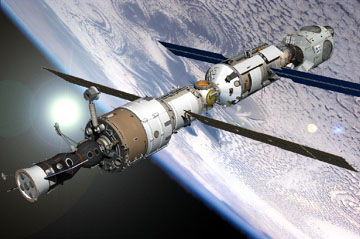This is the official mission patch of STS-97. It shows shuttle Endeavour docking with the ISS. It also shows the solar panels to be delivered to the ISS.
Click on image for full size
Courtesy of NASA
Endeavour to Rendevous with ISS
News story originally written on December 1, 2000
Shuttle Endeavour blasted off on Thursday from Kennedy Space Center at 9:06 p.m. CST. The successful launch began the 11-day STS-97 mission. There are 5 men aboard
the shuttle including Commander
Brent W. Jett, Pilot Michael J. Bloomfield, Mission Specialists Joseph Tanner,
Marc Garneau and Carlos Noriega. The shuttle is also carrying the P6 Integrated Truss Segment, which includes the first U.S. Solar arrays and a power distribution system. The Truss Segment weighs 17 tons and stands as the largest and heaviest piece delivered to the station.
The shuttle crew will work with the three-man crew aboard the Alpha space station. Three space walks will be needed as the 8 men work together to install the 90-foot high, 240-foot wide solar array structure.
This structure will quintuple the station's electrical power. This power will allow for ongoing research to be perfomed onboard the station. These are the first of three solar array sets that will eventually be attached to the station.
The shuttle is scheduled to dock with the International Space Station on Saturday, at 1:57 CST. The shuttle will return to the Kennedy Space Center Shuttle Landing facility on 12/11/00 at 5:19 p.m. CST.
You might also be interested in:

Man has always been compelled to explore and inhabit previously unknown realms. As of this month, man is again inhabiting the daunting expanse we call space. Eight years after the initial agreement to
...more
It was another exciting and frustrating year for the space science program. It seemed that every step forward led to one backwards. Either way, NASA led the way to a great century of discovery. Unfortunately,
...more
The Space Shuttle Discovery lifted off from Kennedy Space Center at 2:19 p.m. EST, October 29th. The sky was clear and the weather was great as Discovery took 8 1/2 minutes to reach orbit for the Unitied
...more
A moon was discovered orbiting the asteroid, Eugenia. This is only the second time in history that a satellite has been seen circling an asteroid. A special mirror allowed scientists to find the moon
...more
Will Russia ever put the service module for the International Space Station in space? NASA officials are demanding an answer from the Russian government. The necessary service module is currently waiting
...more
During a period of about two days in early May, 1998, the ACE spacecraft was immersed in plasma associated with a coronal mass ejection (CME). The SWICS instrument on ACE, which determines unambiguously
...more
J.S. Maini of the Canadian Forest Service has referred to forests as the "heart and lungs of the world." Forests reduce soil erosion, maintain water quality, contribute to atmospheric humidity and cloud
...more















